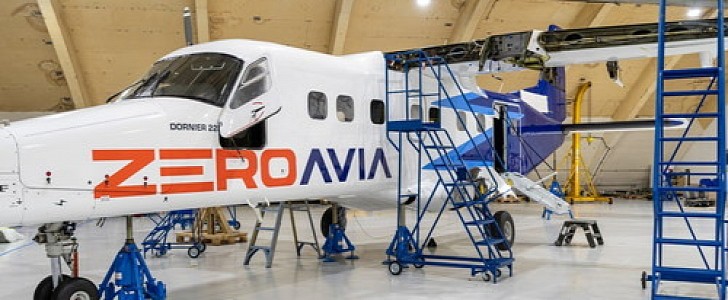ZeroAvia, an aviation company with headquarters in the UK and the U.S., has reached an important milestone on its journey to developing commercial aircraft with hydrogen-electric propulsion. The new collaboration with MHI RJ Aviation Group will speed up the development of future sustainable regional jets.
ZeroAvia, a company that’s supported by the UK's Aerospace Technology Institute and Innovate UK, and is even part of the Prime Minister’s Jet Zero Council, has big achievements and even bigger plans. After having completed more than 35 test flights of a Piper M-class six-seat aircraft equipped with its hydrogen fuel cell powertrain, the company is now converting a larger 19-seat Dornier 228 aircraft, with test flights beginning in the coming months.
ZeroAvia expects to have its 19-seater powertrain certified by 2024, which will be followed by a larger aircraft (50-80 seats) in 2026, and regional jets – by 2028. "We believe that in the future almost every aircraft in the world will be powered by hydrogen-electric engines,” said Val Miftakhov, ZeroAvia CEO. In order to get there, the brand announced a recent agreement with MHI RJ Aviation Group.
Claiming to be the world's largest CRJ Series Aircraft maintenance, repair and overhaul company, MHIRJ is a subsidiary of Mitsubishi Heavy Industries, headquartered in Canada. While ZeroAvia is developing the hydrogen fuel cell powertrain technology for regional jets, MHIRJ will offer support in terms of aircraft design and certification. The two companies are interested not only in developing new regional jets with hydrogen-electric propulsion, but also retrofitting existing aircraft.
According to Hiro Yamamoto, President and CEO of MHIRJ, it’s more convenient to test new technologies on regional jets, before moving to larger commercial aircraft. Plus, these aircraft are an important means of transportation for smaller communities within certain regions. So, developing a clean-energy jet would bring immediate benefits, while also facilitating future developments for larger aircraft.
ZeroAvia expects to have its 19-seater powertrain certified by 2024, which will be followed by a larger aircraft (50-80 seats) in 2026, and regional jets – by 2028. "We believe that in the future almost every aircraft in the world will be powered by hydrogen-electric engines,” said Val Miftakhov, ZeroAvia CEO. In order to get there, the brand announced a recent agreement with MHI RJ Aviation Group.
Claiming to be the world's largest CRJ Series Aircraft maintenance, repair and overhaul company, MHIRJ is a subsidiary of Mitsubishi Heavy Industries, headquartered in Canada. While ZeroAvia is developing the hydrogen fuel cell powertrain technology for regional jets, MHIRJ will offer support in terms of aircraft design and certification. The two companies are interested not only in developing new regional jets with hydrogen-electric propulsion, but also retrofitting existing aircraft.
According to Hiro Yamamoto, President and CEO of MHIRJ, it’s more convenient to test new technologies on regional jets, before moving to larger commercial aircraft. Plus, these aircraft are an important means of transportation for smaller communities within certain regions. So, developing a clean-energy jet would bring immediate benefits, while also facilitating future developments for larger aircraft.



